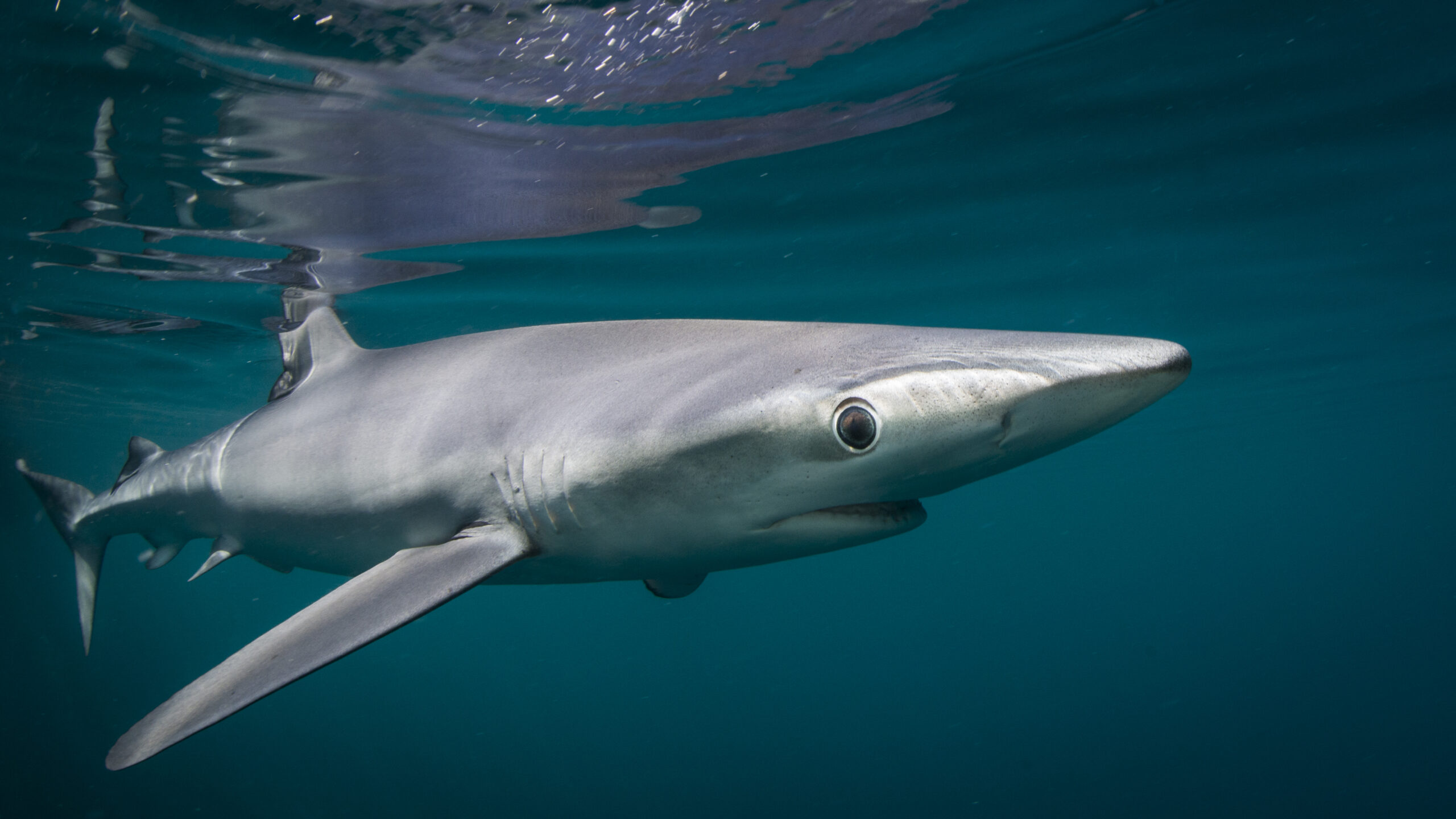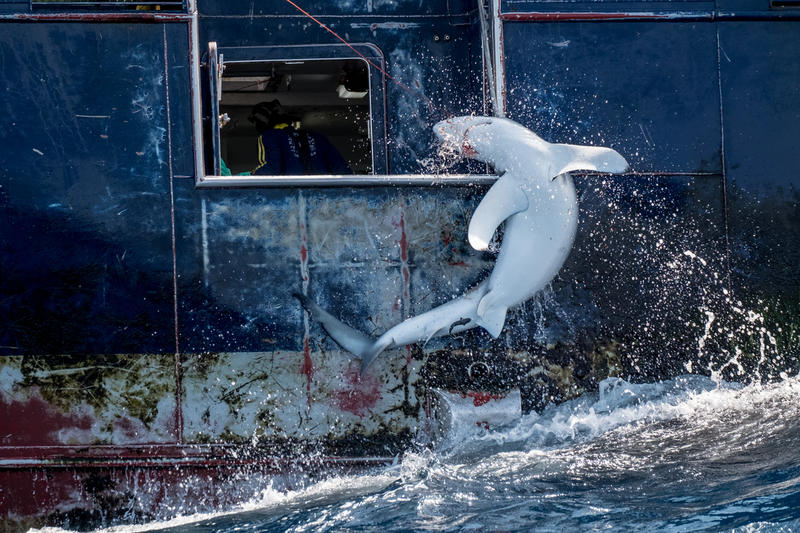- Practically a 3rd of shark meat samples taken from merchandise offered in Europe contained dangerously excessive methylmercury ranges, with all tope shark and virtually 1 / 4 of blue shark samples exceeding EU security limits, a brand new research finds.
- A lot shark meat is mislabeled beneath names like rock salmon, huss or veau de mer, leaving shoppers unaware they’re consuming shark and may very well be ingesting a potent neurotoxin.
- Methylmercury can’t be cooked out, builds up in human tissue and may trigger lasting neurological hurt. In the meantime, shark populations are declining, threatening marine ecosystem stability.
- The research’s authors urge stricter labeling legal guidelines, tighter meals monitoring and shopper training, arguing that consuming apex predators is each ecologically and medically unsustainable.
Shark meat offered throughout Europe could also be serving up greater than seafood. Dangerously excessive ranges of methylmercury, poisonous to people, have been current in practically a 3rd of shark meat samples taken from European eating places, fishmongers and supermarkets, in accordance with a brand new report by a bunch of marine conservation NGOs.
The findings counsel that Europeans are routinely consuming shark meat that may fail meals security assessments if it have been monitored extra carefully.
All tope shark (Galeorhinus galeus) samples and 22.7% of blue shark (Prionace glauca) samples analyzed exceeded secure ranges, some by greater than 4 instances the most permitted in shark meat for human consumption beneath EU guidelines. Common mercury throughout all samples analyzed was lower than a tenth of a milligram per kilogram beneath the utmost permitted, in accordance with the report.
“We have been astonished at how excessive the contamination ranges have been in all the samples,” report co-author and marine biologist Julian Münster of the German marketing campaign group Cease Finning Deutschland, informed Mongabay. “We didn’t anticipate the typical methylmercury contamination to be just under the utmost restrict.”
Who eats shark meat, although? It’s possible you’ll nicely ask. The report, printed Oct. 15, additionally raised issues about deceptive shark-meat labeling, citing examples the place retailers make up names they contemplate extra interesting to shoppers than “shark.” These embody rock salmon or huss in English, schillerlocke in German and veau de mer, roussette or saumonette in French, the report stated.
“As issues stand, individuals are consuming contaminated fish with out even realizing it,” Münster stated.
Bioaccumulation in an apex predator
Human exercise has elevated atmospheric mercury by 450% above pure ranges, in accordance with the U.N. Setting Programme. Mercury enters aquatic environments via human air pollution from industrial emissions and waste incineration. It happens naturally from volcanic exercise and rock weathering.
As soon as within the water, microbes convert mercury into methylmercury and a course of known as bioaccumulation begins: Small organisms on the backside of the meals chain devour methylmercury in tiny portions, then small fish and invertebrates eat them, taking up their mixed mercury load. Bigger fish, and ultimately sharks, eat these mercury-laced prey fish. Methylmercury stays in fish for round two years, in accordance with earlier analysis. In the meantime, the extra mercury-containing prey a fish eats, the extra mercury builds up in its muscle tissues, which can find yourself in your plate.
Massive predators, like sharks, are recognized to build up particularly excessive doses over their lengthy lifespans, with older and bigger sharks possible carrying the heaviest hundreds.
Methylmercury can’t be eliminated by cooking or freezing, and it accumulates within the human physique over time, simply as in fish. At excessive sufficient doses, it may well trigger neurological points, corresponding to uncontrollable shaking, reminiscence loss, blindness and seizures. The consequences are sometimes everlasting. Fetuses and younger youngsters are particularly at danger.
Consumption of shark meat additionally raises issues for the sharks themselves. As apex predators, sharks are “important” to wholesome marine ecosystems, Münster stated. But many species are in decline as a result of their low delivery charges imply they usually can’t maintain the excessive fishing ranges they’re topic to.
Conservationists have lengthy sounded the alarm concerning the commerce in shark fins, pushed largely by demand in Asia, whereas the marketplace for shark meat has largely escaped public consideration. But meat earned virtually twice the income of fins between 2012 and 2019, at $2.6 billion, WWF analysis discovered. European imports and exports account for 22% of the worldwide shark meat commerce, it confirmed, with Spain the most important exporter.

Contained in the report
The report examined 51 shark meat samples from France, Germany, Spain, Switzerland and the U.Ok., 44 from blue sharks and 7 from tope sharks. The samples have been deep-frozen and analyzed for methylmercury focus in an Worldwide Group for Standardization-certified lab.
The researchers selected blue shark as a result of it’s the commonest shark species on the European market. Forty of the samples have been traceable to North and East Atlantic fisheries, with virtually 1 / 4 displaying mercury ranges exceeding the EU’s permitted most of 1 mg of mercury per kg of meat.
All the tope shark samples exceeded the EU’s permitted most, with as much as 3 mg of methylmercury per kg. The report’s authors be aware that the tope pattern measurement of seven specimens, all from the Spanish market, was restricted.
The report shouldn’t be peer-reviewed, however was proofread by Bethanie Carney Almroth, a professor of ecotoxicology on the College of Gothenburg. The authors, from German analysis and conservation group Elasmocean, Swiss environmental philanthropy the Gallifrey Basis, in addition to Cease Finning Deutschland, determined towards submitting their work to a scientific journal at this stage to tell the general public rapidly, Münster stated.
This report is necessary for shark populations, that are declining, in addition to for human well being, Neil Hammershlag, a marine ecologist and govt director of the Florida-based Shark Analysis Basis, who was not concerned within the report, informed Mongabay. “I believe we shouldn’t be consuming top-level predators,” he stated. “Massive apex predators usually are not solely uncommon, however consuming them is dangerous for our well being.”
Analysis like this might help folks make knowledgeable selections about what they eat, however provided that they realize it, he added. “What is required now could be spreading that consciousness,” he stated.
Anne-France Mattlet, Tuna Group director of the principle consultant physique for EU fishers, Europêche, rejected the notion that shark meat is unhealthy in an electronic mail to Mongabay.
“Consuming predators, together with sharks, shouldn’t be harmful on your well being. It’s true that predators comprise extra mercury than different species, for being on the high of the meals chain,” she stated, however mercury checks are “rigorous” and happen all through the provision chain. “The principles and thresholds on mercury exist to guard the patron. … Any batch of fish that exceeds the permitted ranges is both stopped or returned,” she stated.
“What issues us about mercury bioaccumulation is the rising strain, pushed not by science however by misinformation and pretend information, which is pushing shoppers away from seafood, with dangerous penalties for eating regimen and well being,” Mattlet stated.
Fish and seafood are good sources of protein, important vitamins and polyunsaturated fatty acids. Individuals ought to proceed to eat them, Mattlet stated, citing the European Meals Security Authority (EFSA), which beneficial 1-4 servings of fish per week in 2015.
The EFSA additionally beneficial that “species with a excessive content material of mercury within the day by day eating regimen ought to be restricted” to guard towards neurodevelopmental results.

What ought to be completed?
The report urges governments to strengthen seafood labeling legal guidelines, implement stricter monitoring of mercury ranges in shark meat and inform shoppers concerning the hazards of consuming massive predatory fish. It emphasizes that shark consumption ought to be minimized or averted altogether. Münster additionally famous the necessity to cut back anthropogenic releases of mercury into the setting.
“[T]he fishing trade, retailers and politicians have a duty to teach shoppers” so folks could make reasoned selections about their mercury consumption, Münster stated. “With our starvation for contaminated shark meat and tasteless shark fins, we’re endangering our personal livelihoods.”
Banner picture: A shark is hauled into the maintain of the Pedra da Grelo, a Spanish longliner focusing on swordfish within the South Atlantic Ocean, in 2019. Picture courtesy of © Tommy Trenchard / Greenpeace.
Citations:
Tollefson, L., & Cordle, F. (1986). Methylmercury in fish: A overview of Residue Ranges, fish consumption and regulatory motion in america. Environmental Well being Views, 68, 203. doi:10.2307/3430265
Myers, G. J., & Davidson, P. W. (1998). Prenatal methylmercury publicity and youngsters: Neurologic, developmental, and behavioral analysis. Environmental Well being Views, 106, 841. doi:10.2307/3434199
That ‘fish’ on the menu? In Brazil’s faculties and prisons, it’s usually shark
FEEDBACK: Use this way to ship a message to the editor of this submit. If you wish to submit a public remark, you are able to do that on the backside of the web page.
